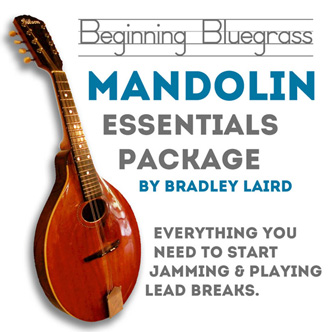| FREE
MANDOLIN LESSON 6 - by Bradley Laird

EXERCISE
10 - THE NAMES OF THE "NATURAL" NOTES
Here are the names of the "natural" notes found on each
string. Remember that the open strings are simply the name of the
note which the string is tuned to.

You should learn the names of each of these notes and be able to
find them. (You will not accomplish this in one day. Just take
your time and review it a few minutes each time you get your mandolin out
to play. It will give you something useful to do when your fingers get
sore!) These notes will become a "roadmap" to
help you know where to play chords, and will allow you to find
all of
the
other
notes on the fingerboard. Notice how the note names
ascend in "ABC" fashion. From
A to G and then just go on repeating.
EXERCISE 11 - FLATS AND SHARPS
If you go down one fret from a natural note, you have "flatted
the note". If you raise a note by one fret, you have "sharped
the note". In this example we start with
an "A" note. By dropping
down one fret, we have made "A flat" (written Ab).

By
raising the A note one fret, we have made A sharp. (Written A#).
Here now are all of the notes on each string. This squence is known
as the chromatic scale. The notes are filled in for the first measure.
Using what you have learned so far, try to say aloud the note names
for the rest of the measures. You might even want to print this
page and write the notes names above each number on the tab. (Just
to be sure you really understand what's going on here and to give
you some homework!)

Look
again at measure one and notice that the second note (G sharp)
is played at the first fret. In the explanation of flats and
sharps we said that this note was called Ab.
This note actually has two names. It can be called G# or Ab. Same
for all of the flats and sharps. Db is also called C#.
Important: There is no B# or E#. A B# simply is called C. And an
E# is called F. The reverse is also true that there is no Cb. It
is just called B. And Fb is called E. Other than those two exceptions,
it is fairly simple.
NOTE ABOUT TABLATURE vs STANDARD NOTATION
If you know how to read standard musical notation, the names of
the notes will be much clearer than with tablature. Tablature is
simply a diagram of where to put your fingers. There are some great
benefits to be gained by learning to read
standard notation as well as tablature. Thousands of songs are published
in standard notation and only
a small percentage are in tablature. Tablature has its benefits,
however, in that it is easier to understand
quickly. Both forms have their pros and cons and I suggest that all
players learn both systems.
Roger
that! Take me
to lesson
7.

|
This download lesson package contains 3 eBooks, 36 tracks and 3 Video lessons specifically designed for beginners.
This will get your ready for the jam sessions! See everything it contains by clicking this link.
|
| 






